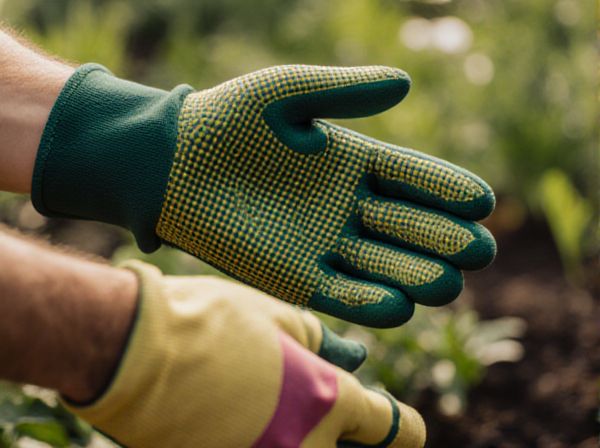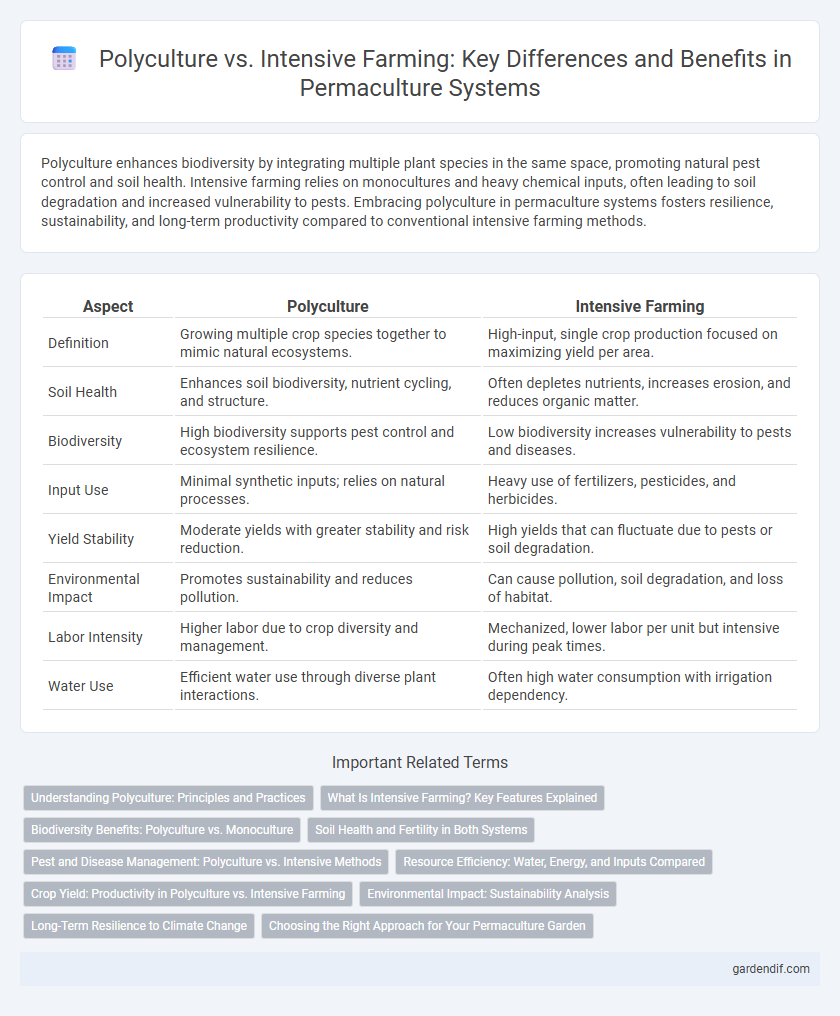
Polyculture vs Intensive Farming Illustration
Polyculture enhances biodiversity by integrating multiple plant species in the same space, promoting natural pest control and soil health. Intensive farming relies on monocultures and heavy chemical inputs, often leading to soil degradation and increased vulnerability to pests. Embracing polyculture in permaculture systems fosters resilience, sustainability, and long-term productivity compared to conventional intensive farming methods.
Table of Comparison
| Aspect | Polyculture | Intensive Farming |
|---|---|---|
| Definition | Growing multiple crop species together to mimic natural ecosystems. | High-input, single crop production focused on maximizing yield per area. |
| Soil Health | Enhances soil biodiversity, nutrient cycling, and structure. | Often depletes nutrients, increases erosion, and reduces organic matter. |
| Biodiversity | High biodiversity supports pest control and ecosystem resilience. | Low biodiversity increases vulnerability to pests and diseases. |
| Input Use | Minimal synthetic inputs; relies on natural processes. | Heavy use of fertilizers, pesticides, and herbicides. |
| Yield Stability | Moderate yields with greater stability and risk reduction. | High yields that can fluctuate due to pests or soil degradation. |
| Environmental Impact | Promotes sustainability and reduces pollution. | Can cause pollution, soil degradation, and loss of habitat. |
| Labor Intensity | Higher labor due to crop diversity and management. | Mechanized, lower labor per unit but intensive during peak times. |
| Water Use | Efficient water use through diverse plant interactions. | Often high water consumption with irrigation dependency. |
Understanding Polyculture: Principles and Practices
Polyculture integrates diverse plant species within a single ecosystem, enhancing soil health, pest control, and biodiversity by mimicking natural habitats. Its principles emphasize crop diversity, complementary species interactions, and resource-use efficiency to create resilient agricultural systems. Practices include intercropping, agroforestry, and companion planting, which collectively reduce dependency on chemical inputs while promoting sustainable yields.
What Is Intensive Farming? Key Features Explained
Intensive farming is an agricultural system designed to maximize crop yields through high inputs of labor, fertilizers, pesticides, and mechanization. Key features include monoculture planting, soil tillage, irrigation management, and the use of synthetic chemicals aimed at boosting production efficiency. This approach contrasts with polyculture methods by prioritizing short-term output over ecological balance and biodiversity.
Biodiversity Benefits: Polyculture vs. Monoculture
Polyculture systems enhance biodiversity by cultivating multiple crop species simultaneously, which fosters diverse habitats for beneficial insects, microorganisms, and wildlife. In contrast, intensive monoculture farming reduces species variety, leading to ecosystem imbalances and increased vulnerability to pests and diseases. Diverse plant interactions in polyculture improve soil health, nutrient cycling, and resilience, making it a sustainable alternative to conventional monoculture methods.
Soil Health and Fertility in Both Systems
Polyculture enhances soil health by promoting biodiversity, which improves nutrient cycling and reduces pest outbreaks, leading to sustained fertility without excessive chemical inputs. Intensive farming often depletes soil nutrients rapidly through monocropping and heavy use of synthetic fertilizers, resulting in decreased soil structure and long-term fertility loss. Integrating diverse plant species in polyculture systems supports organic matter accumulation and microbial activity, crucial for maintaining soil resilience and productivity.
Pest and Disease Management: Polyculture vs. Intensive Methods
Polyculture promotes natural pest and disease control by increasing biodiversity, which disrupts pest cycles and supports beneficial predator populations. Intensive farming often relies on chemical pesticides and monocultures, leading to pest resistance and reduced soil health. Integrating diverse crops in polyculture systems enhances ecological balance, minimizing the need for synthetic interventions.
Resource Efficiency: Water, Energy, and Inputs Compared
Polyculture systems enhance resource efficiency by mimicking natural ecosystems, reducing water use through diverse plant interactions that improve soil moisture retention. Intensive farming demands higher energy inputs and often relies on synthetic fertilizers and pesticides, leading to increased water contamination and resource depletion. The integration of multiple crops in polyculture optimizes nutrient cycling and minimizes external inputs, fostering sustainable resource management.
Crop Yield: Productivity in Polyculture vs. Intensive Farming
Polyculture enhances overall crop yield by diversifying plant species, which leads to more efficient resource use and pest control compared to intensive farming's monoculture approach. Intensive farming maximizes yield per crop through specialized inputs and mechanization but often depletes soil health and reduces biodiversity over time. Studies indicate that polyculture systems can achieve comparable or higher total productivity by optimizing complementary interactions among crops.
Environmental Impact: Sustainability Analysis
Polyculture enhances environmental sustainability by promoting biodiversity, improving soil health, and reducing pest outbreaks through natural ecosystems. Intensive farming often depletes soil nutrients, increases chemical runoff, and contributes to habitat loss, resulting in long-term ecological degradation. Sustainable agriculture favors polyculture systems to maintain ecosystem balance and reduce negative environmental footprints.
Long-Term Resilience to Climate Change
Polyculture systems enhance long-term resilience to climate change by promoting biodiversity, improving soil health, and reducing vulnerability to pests and diseases. Intensive farming often relies on monocultures and chemical inputs, which can degrade soil quality and increase susceptibility to extreme weather events. Integrating diverse plant species in permaculture designs supports ecosystem stability and sustainable food production under shifting climate conditions.
Choosing the Right Approach for Your Permaculture Garden
Polyculture enhances biodiversity and soil health by cultivating multiple plant species together, creating resilient ecosystems in permaculture gardens. Intensive farming maximizes yield per square foot through focused planting and resource management but can strain soil fertility over time. Selecting the right approach depends on garden size, local climate, and long-term sustainability goals.
Polyculture vs Intensive Farming Infographic

 gardendif.com
gardendif.com